For one week in December, eager, participatory shouts of children filled the Art Galleries at Black Studies. Multicolored origami carved a path through the Blanton Museum of Art, while other days, intergenerational conversations reverberated off its atrium walls. Children learned about abstract art, teenage immigrants reflected on belonging and adults reminisced on fond memories, all through performances by Theatre and Dance students. Though their pieces were vastly different, each group of students shared a common goal – making a performance with specific audiences that would help participants share and understand their own stories.
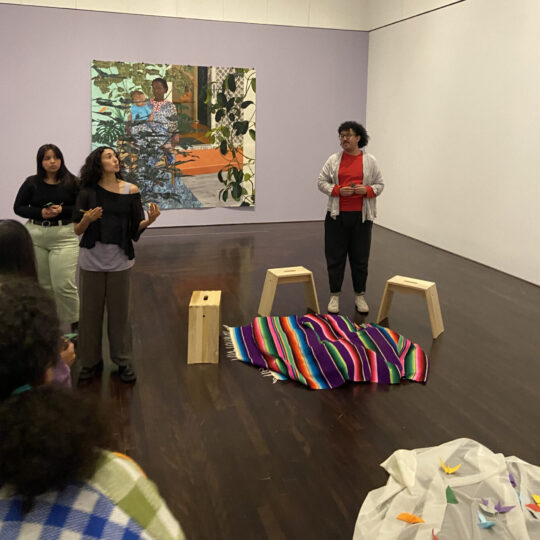
Preparations for these museum performances started last fall in Katie Dawson’s Drama and Theatre Applications in Museums course. Dawson split her class into groups, assigning them each a museum to perform in and a community organization who would serve as their audience. One of the main goals of the course, according to Dawson, was “to think about access, inclusion and belonging in museums especially in regard to special populations.” Students worked closely with their community partners during their devising process, making artwork more approachable through performances and facilitated discussions.
Once they received their assignments, each group selected the artwork that would influence their performances. One piece, entitled “Metamorphosis,” was performed for and with GirlForward, an organization supporting young girls who identify as refugees or immigrants. They looked for pieces that fit with themes of “home, transition and waiting,” shared group member Lily Odekirk, eventually selecting artwork by Joey Fauerso, Deborah Roberts and Njidkeka Akunyili Crosby. The group knew they wanted to incorporate various art forms into their performance, so they also selected pieces based on the atmosphere of the galleries themselves. They collected and shared photos that reminded audiences of home, used origami as a tangible community building tool and engaged audiences in conversations that were woven into the performance.
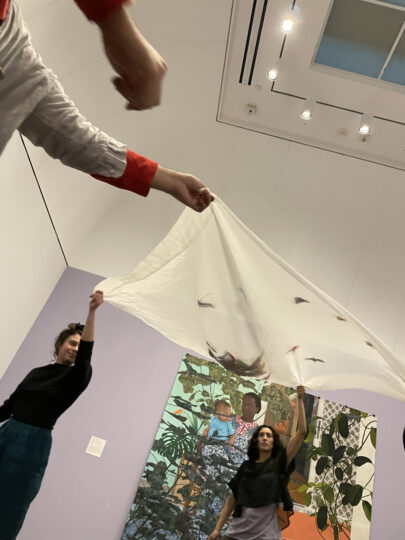
Each group learned quickly that working with community partners and performing in museum spaces would require flexibility, but the challenges they encountered provided fertile soil for creative problem solving. “If we can’t run through the gallery then how do we communicate the same thing without doing that?” mused Mateo Hernandez. Another group who were working with older adults from Heritage Park Rehabilitation and Skilled Nursing Center presented their piece, entitled “AquariART,” on elementary school field trip day. While the sounds of children moving through the space was occasionally overwhelming, the group broke out into one-on-one conversations with their audience members to help focus and generate genuine connections.
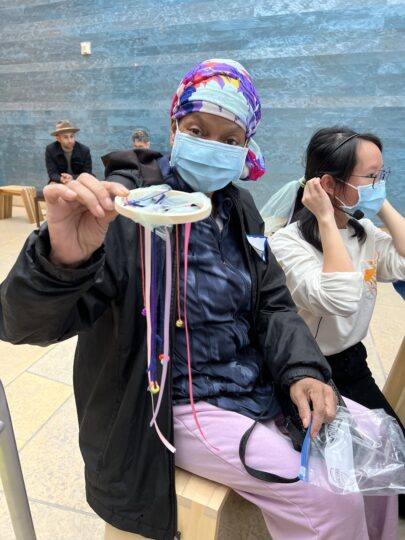
“AquariART” focused on two art pieces in the Blanton Museum of Art’s atrium – Siphonophora by Thomas Glassford and Stacked Waters by Teresita Fernández. Not only were these art pieces easily accessible for audiences who use wheelchairs and walkers, they also fit nicely as metaphors for memory and community. The group used a layered approach during their performance, which began with a description of a journey into the depths of the ocean. From there, they folded in audience responses, culminating in participant-led artmaking involving crafts and discussions that focused on their memories of water. “We were also trying to make the connection of how art is something you look at, you appreciate, but also something you make with your own personal experience,” shared Xinyue Zhang. Folks spoke of their unique lived experiences, from beachgoers to a Navy veteran whose fondest memories of the water had more to do with the people around him.
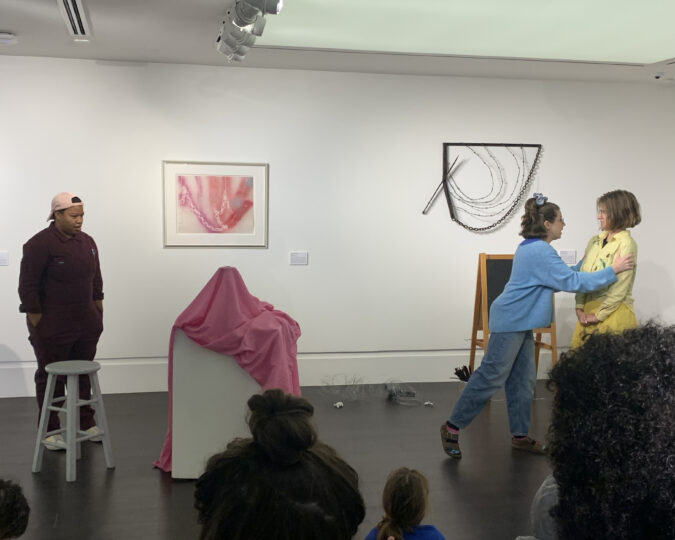
Throughout their rehearsals and performances, each group leaned on the resources their community partners provided them. The “AquariART” team worked closely with Heritage Park and Creative Action to make sure their presentation fit for their audience, incorporating PowerPoints, chair yoga and tangible elements to keep audiences engaged and meet various sensory needs. The third group, presenting a piece they called “The Materials that Make Us,” stayed in close contact with Kendyll Gross at The Art Gallery at Black Studies. She was attentive and welcoming, allowing them extra time in the gallery for an added performance. As Claire Derriennic noted, their performance was even inspired by the ways Gross spoke about “seeing multiple meanings in each piece of art” while giving them a tour through the space.
With the backdrop of the Melvin Edwards: WIRE(D) and CHAIN(ED) exhibit, “The Materials that Make Us” team explored abstract art with kindergarten and first grade students. The group devised an interactive play with three approachable characters, engaging their young audience with themes of multiplicity and storytelling through art. They then carried these themes over into a post-performance craft, inviting children to explore emotions by making their own sculptures. “I was impressed with the students’ ability to engage with harder emotions as well [as happy emotions],” Erin Valentine shared. Children were then encouraged to reflect on their sculptures and the stories behind their work.
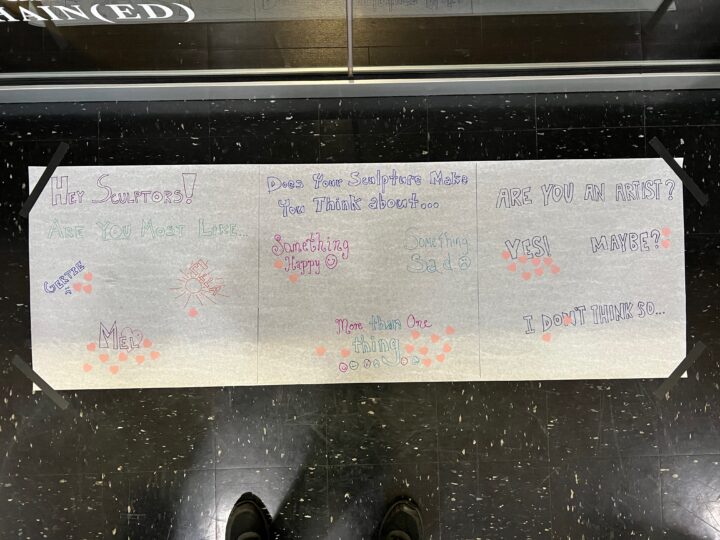
With such specialized performances, each group left with a deeper understanding of their population. The team behind “The Materials that Make Us” were surprised at the difference between their first-grade audience, who were excited to participate in the play, and their kindergarten audience, who engaged more with hands-on artmaking. Students working on “Metamorphosis” commented on the ways that audience input shaped their work, resulting in two very different performances. “AquariART” hinged on audience participation, and the older adults’ eagerness to participate brought new energy to their performance.
Each group’s thoughtfulness in working with their community partners is what made their performances shine. No group talked at their audiences; instead, they created work specifically with their population’s experiences in mind, welcoming their participation. “It’s a lot of meeting folks where they are,” noted Hernandez. “That’s the biggest community engagement tenet we were working by.”
Katie Dawson’s Drama and Theatre Applications in Museums course included graduate and undergraduate students from across the department, including Stephanie Keller, Madelyn Morneault, Lauren Mural, Hannah Neuhauser, Xinyue Zhang, Michael DeWhatley, Claire Derriennic, Renita James, Erin Valentine, Venese Alcantar, Mateo Hernandez, Lily Odekirk and Cielo Ortiz. A handful of these students will transfer their museum theatre performance to the Children’s Museum of Pittsburgh this summer. They’ll perform for young audiences in collaboration with Opposites Abstract: A Mo Willems Exhibit on May 19-20, 2023.
Written by Sydney Pattillo.

